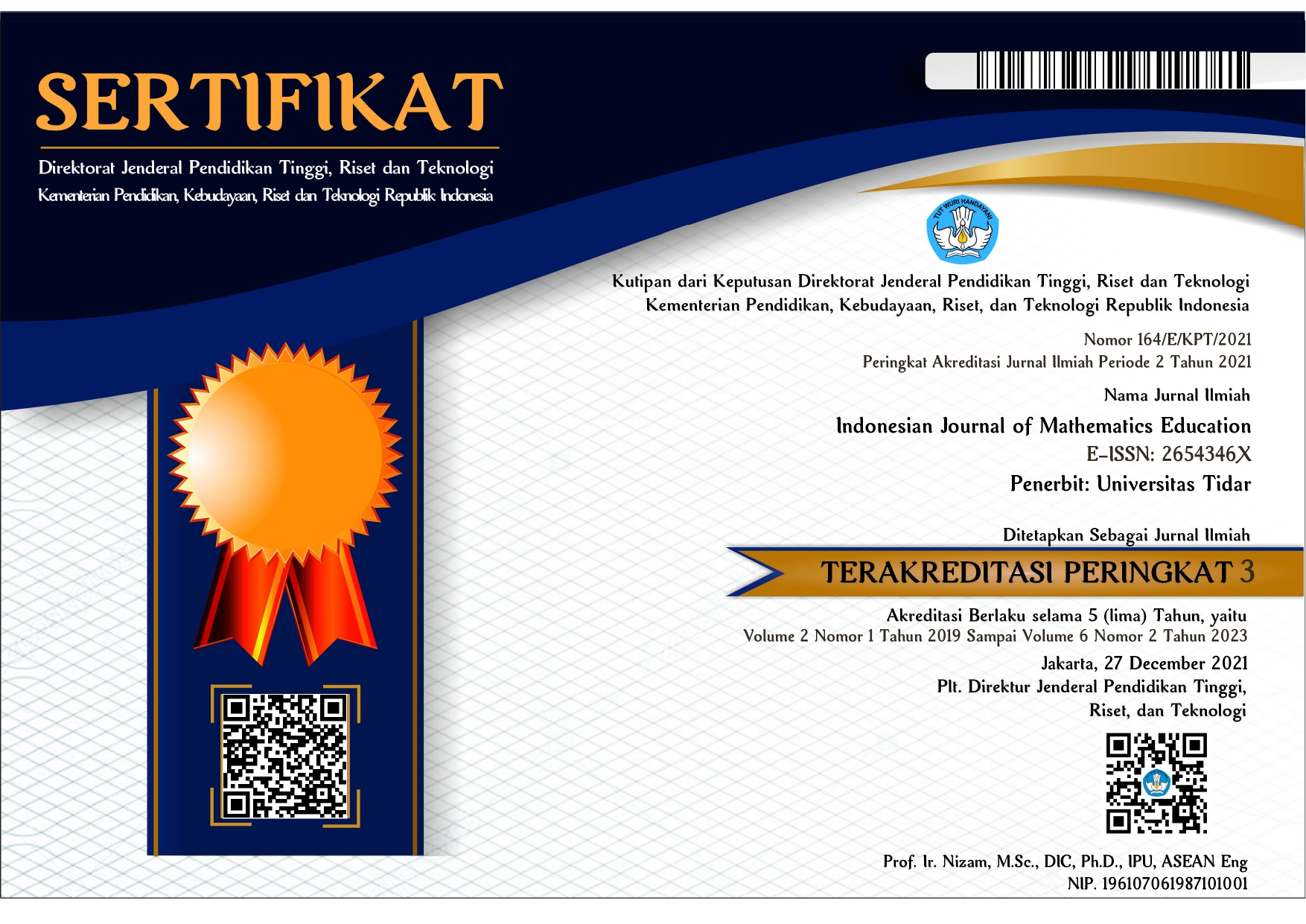Students' Mathematical Literacy in Solving PISA Model Questions: A Case Study of Systematic and Intuitive Cognitive Style
Keywords:
intuitive cognitive style, mathematical literacy, PISA Model, systematic cognitive styleAbstract
This research is a qualitative descriptive study that aims to describe the mathematical literacy of high school students with a systematic and intuitive cognitive style in solving PISA model questions. The cognitive style test, cognitive style inventory, and mathematics ability test were used to select research subjects. One student with a systematic cognitive style and one with an intuitive cognitive style were selected with equivalent mathematical abilities and the same gender. The results of the mathematical literacy test and test-based interviews were used to collect data on students' mathematical literacy. Time triangulation was used to test the credibility of the findings obtained. Data analysis techniques include data reduction, presentation, and drawing conclusions. The research results show that in formulating problems, systematic students identify the information obtained from the two questions in more detail and are more careful in understanding the questions, while intuitive students identify the necessary information to solve the problem in general. In applying problems, systematic students design and use strategies to find solutions, identifying known information from the problem first, while intuitive students create and use strategies to find solutions and solve problems using the concept of comparison. For the interpreting aspect, the two students reinterpreted the mathematical results they obtained into contextual problems, stated the truth of the answers they obtained, and provided arguments to support their answers.
References
Au, A. K. M. (1997). Cognitive style as a factor influencing performance of business students across various assessment techniques: A preliminary study. Journal of Managerial Psychology, 12(4), 243-250. https://doi.org/10.1108/02683949710174847
Fadillah, L., Kartono, & Supriyadi. (2019). Peran tutor feedback dalam pembelajaran model PBL pada pencapaian kemampuan komunikasi matematis ditinjau dari gaya kognitif siswa. PRISMA, Prosiding Seminar Nasional Matematika, 2, 533–539. https://journal.unnes.ac.id/sju/prisma/article/view/29047
Güzel, Ç. İ., & Berberoğlu, G. (2010). Students’ affective characteristics and their relation to mathematical literacy measures in the Programme for International Student Assessment (PISA) 2003. Egitim Arastirmalari-Eurasian Journal of Educational Research, 40(Summer), 93-112. https://ejer.com.tr/wp-content/uploads/2021/01/ejer_2010_issue_40.pdf#page=94
Hamidy, A., & Prabowo, B. S. (2020). Literasi matematika siswa SMP IT Cordova ditinjau dari domain konteks. Tarbiyah Wa Ta’lim: Jurnal Penelitian Pendidikan dan Pembelajaran, 7(2), 69–80.
Hidayat, A. F., Amin, S. M., & Fuad, Y. (2017). Profil penalaran proporsional siswa SMP dalam memecahkan masalah matematika berdasarkan gaya kognitif sistematis dan intuitif. Kreano: Jurnal Matematika Kreatif-Inovatif, 8(2), 162–170. https://doi.org/10.15294/kreano.v8i2.9635
Jain, R. R., & Kumar, R. (2013). Cognitive style and metacognitive awareness in adults. Prachi Journal of Psychocultural Dimension, 29, 1–14.
Khoyimah, I. N. (2021). Profil berpikir relasional siswa SMP dalam menyelesaikan masalah matematika ditinjau dari gaya kognitif sistematis-intuitif. MATHEdunesa, 10(2), 396–409. https://doi.org/10.26740/mathedunesa.v10n2.p396-409
Mahmudah, L., & Setianingsih, R. (2022). Kemampuan literasi statistis siswa sma ditinjau dari gaya kognitif sistematis dan intuitif. Jurnal Ilmu Pendidikan Matematika, 11(1), 255–267. https://doi.org/10.26740/mathedunesa.v11n1.p255-267
Mansur, N. (2018). Melatih literasi matematika siswa dengan soal PISA. Prisma, Prosiding Seminar Nasional Matematika, 1, 140–144.
Martin, L. P. (1998). The cognitive-style inventory. The Pfeiffer Library, 8(1), 1–18. https://home.snu.edu/~jsmith/library/body/v08.pdf
Muhtarom, Sugiyanti, Utami, R. E., & Indriana, K. (2018). Metacognitive ability of male students: Difference impulsive-reflective cognitive style. Journal of Physics: Conference Series, 983(1). https://doi.org/10.1088/1742-6596/983/1/012118
Nurdianasari, H., Rochmad, & Hartono. (2015). Kemampuan literasi matematika siswa kelas VIII berdasarkan gaya kognitif. Unnes Journal of Mathematics Education, 4(2), 76–83. https://journal.unnes.ac.id/sju/ujmer/article/view/9833/6285
Nurjanah, A., & Saputra, D. C. (2023). Mathematical literacy skills: A survey in secondary schools. Jambura Journal of Mathematics Education, 4(1), 35-49. https://doi.org/10.34312/jmathedu.v4i1.18776
OCED. (2017). PISA for Development Assessment and Analytical Framework: Reading, Mathematics and Science. OECD Publishing.
OECD. (2019). PISA 2018 Assessment and Analitytical Framework. PISA. https://doi.org/https://doi.org/10.1787/b25efab8-en
Pangastuti, D. A., Nugroho, A. A., & Muhtarom. (2022). Kemampuan penalaran matematis siswa kelas XI dalam menyelesaikan soal barisan aritmetika berdasarkan gaya kognitif sistematis dan intuitif. Imajiner: Jurnal Matematika dan Pendidikan Matematika, 4(5), 386–392. https://journal.upgris.ac.id/index.php/imajiner/article/view/10949
Pratama, A. R., Saputro, D. R. S., & Riyadi, R. (2018). Problem solving of student with visual impairment related to mathematical literacy problem. Journal of Physics: Conference Series, 1008(1). https://doi.org/10.1088/1742-6596/1008/1/012068
Rifai, & Wutsqa, D. U. (2017). Mathematical literacy of state junior secondary school students in Bantul Regency. Jurnal Pendidikan Matematika dan Sains, 4(2), 152–162. https://journal.uny.ac.id/index.php/jpms/article/view/15747
Rizki, L. M., & Priatna, N. (2019). Mathematical literacy as the 21st century skill. Journal of Physics: Conference Series, 1157(4). https://doi.org/10.1088/1742-6596/1157/4/042088
Sagiv, L., Amit, A., Ein-Gar, D., & Arieli, S. (2014). Not all great minds think alike: Systematic and intuitive cognitive styles. Journal of Personality, 82(5), 402–417. https://doi.org/10.1111/jopy.12071
Smith, E. R., & DeCoster, J. (2000). Dual-process models in social and cognitive psychology: Conceptual integration and links to underlying memory systems. Personality and Social Psychology Review, 4(2), 108–131. https://doi.org/10.1207/S15327957PSPR0402_01
Subanji, S., Sa’dijah, C., Syuhriyah, K., & Anwar, L. (2021, March). Students’ thinking process in solving two variables linear equation system problem based on systemic and intuitive cognitive style. In AIP Conference Proceedings (Vol. 2330, No. 1). AIP Publishing. https://doi.org/10.1063/5.0043732
Wardono, & Kurniasih, A. W. (2015). Peningkatan literasi matematika mahasiswa melalui pembelajaran inovatif realistik e-learning edmodo bermuatan karakter cerdas kreatif mandiri. Kreano: Jurnal Matematika Kreatif-Inovatif, 6(1), 95–102. https://doi.org/10.15294/kreano.v6i1.4978
Published
How to Cite
Issue
Section
Copyright (c) 2024 Indonesian Journal of Mathematics Education

This work is licensed under a Creative Commons Attribution-NonCommercial-ShareAlike 4.0 International License.









